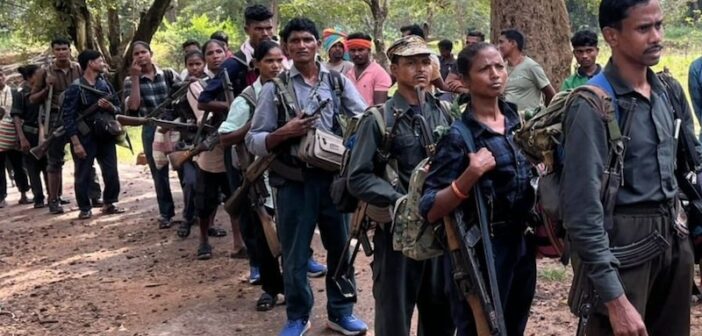TL;DR After decades of bloodshed, Left-Wing Extremism (LWE), often interchanged with Naxalism, seems to be entering its final phase. Data from the Ministry of Home Affairs (MHA) shows that more than 1500 cadres have surrendered in 2025 alone, and violent incidents have fallen by over 78% since 2010, while deaths have dropped from 908 in 2009 to just 130 in 2024. Yet, the insurgency’s remnants persist in a few districts across Chhattisgarh, Jharkhand, Maharashtra, Odisha, and Bihar that still record hundreds of skirmishes and casualties.
Context
Left-Wing Extremism (LWE) emerged in the late 1960s as a violent movement against perceived social and economic injustice, primarily in India’s rural and tribal belts. Over time, it evolved into a full-fledged armed insurgency targeting security forces, infrastructure, and civilians they deemed as informers.
For decades, it remained one of India’s most persistent internal security threats. States like Chhattisgarh, Jharkhand, Bihar, Maharashtra, Telangana and Odisha formed the core of the so-called “Red Corridor.”
Who Compiles This Data?
The data on LWE incidents and fatalities is collected annually by the Ministry of Home Affairs (MHA) through its Left-Wing Extremism Division. It featured in MHA’s annual reports until 2021. More recent figures are sourced from Parliament’s Questions and Answers.
Where can I download Clean & Structured Data about Left Wing Extremism?
Clean, structured, and ready-to-use datasets related to Year and state-wise Left-Wing Extremism (LWE) Incidents and Deaths can be downloaded from Dataful.
Key Insights
The Long Descent: Two Eras of the Naxal Conflict
Between 2009 and 2016, India recorded over 12,010 LWE-related violent incidents and 4,154 deaths, an average of more than 500 deaths per year. This period marked the height of the insurgency, when vast stretches of central and eastern India, from Gadchiroli to Gaya, were under Naxal influence.
A transformation began after 2017. Between 2017 and 2024, total incidents halved to 5,819, while deaths dropped to 1,402, a 66% decline in violence compared to the previous era. The data confirms what security analysts have long observed: the movement has weakened in intensity and shrunk geographically.
The trend reflects a decisive weakening of Naxal influence post-2016, when government forces ramped up targeted operations, built security camps deep inside forests, and expanded road and telecom connectivity across previously inaccessible zones.
2017–2024: The Geography of Decline
Even in the later phase, Chhattisgarh continues to dominate India’s LWE map. Between 2017 and 2024 alone, the state reported 833 deaths across 2,610 incidents, accounting for nearly 60% of all fatalities in the country.
Jharkhand, Bihar, Maharashtra, and Odisha follow far behind, yet together they make up the remaining strongholds.
A notable outlier is Kerala, which recorded 13 incidents but zero deaths, underscoring how the residual Maoist presence there has lost operational strength.
The concentration of violence in a handful of states reflects a territorial contraction from the once-sprawling “Red Corridor” covering 126 districts in 2010 to barely 6 districts in 2025.
Understanding the Decline: Data and Implications
The quantitative drop in violence corresponds with qualitative changes in India’s counter-insurgency architecture:
- Fortified Security Infrastructure: Over 570 fortified police stations and 330+ new security camps have been established since 2014.
- Technology-Driven Policing: Intelligence-led precision operations are now possible thanks to drones, AI surveillance, and satellite mapping.
- Development Push: Over ₹20,000 crore has been sanctioned for 17,000 km of roads, and 8,000+ 4G towers have been approved in LWE-affected areas.
However, the data also exposes enduring gaps. In Chhattisgarh’s interior belts, such as Narayanpur, Sukma, and Bijapur, poor internet access and logistical hurdles still limit civilian administration. Villages like Garpa and Kasturmetta, recently reclaimed from insurgent control, remain hours or even days away from essential services.
The Cost of a Ceasefire That Never Was
While the data suggests victory, the lived reality in many tribal areas remains complex. A fall in fatalities does not necessarily translate into complete peace. Sporadic ambushes, landmine blasts, and intimidation still continue.
The fatality ratio, calculated as deaths per incident, dropped from 0.35 in 2009–2016 to 0.27 in 2017–2024. This points to less intense clashes rather than their complete absence.
Moreover, the core grievances of the movement – land rights, forest access, and governance deficits- persist beneath the surface. The shift from open warfare to isolated acts of violence mirrors a movement in retreat, not extinction.
Where the Red Still Flickers
As of 2025, six districts remain under the “most affected” category, which are largely clustered in south Bastar. These include Bijapur, Kanker, Narayanpur, and Sukma (Chhattisgarh); West Singhbhum (Jharkhand); and Gadchiroli (Maharashtra).
Experts warn that if development is not inclusive, or if rehabilitation fails to sustain livelihoods, extremist ideologies may resurface in new forms. The lesson from the data is clear: security can defeat violence, but only governance can defeat extremism.
Why It Matters
From over 2,200 attacks in 2009 to fewer than 500 in 2024, India’s campaign against Left-Wing Extremism represents one of the world’s most extensive internal security successes. Yet, behind these declining numbers lies an unfinished story of roads that end in forests, of villagers who walk days for rations, and of a state still learning to fill the vacuum it has reclaimed.
Key Numbers (2009–2024)
- Total Incidents: 17,199
- Total Deaths: 5,556
- Peak Year: 2010 (1,005 deaths)
- Lowest Year: 2022 (98 deaths)
- Decline (2009–2024): 66% drop in deaths, 79% drop in incidents
- Most Affected State (2017–2024): Chhattisgarh – 833 deaths, 2,610 incidents



